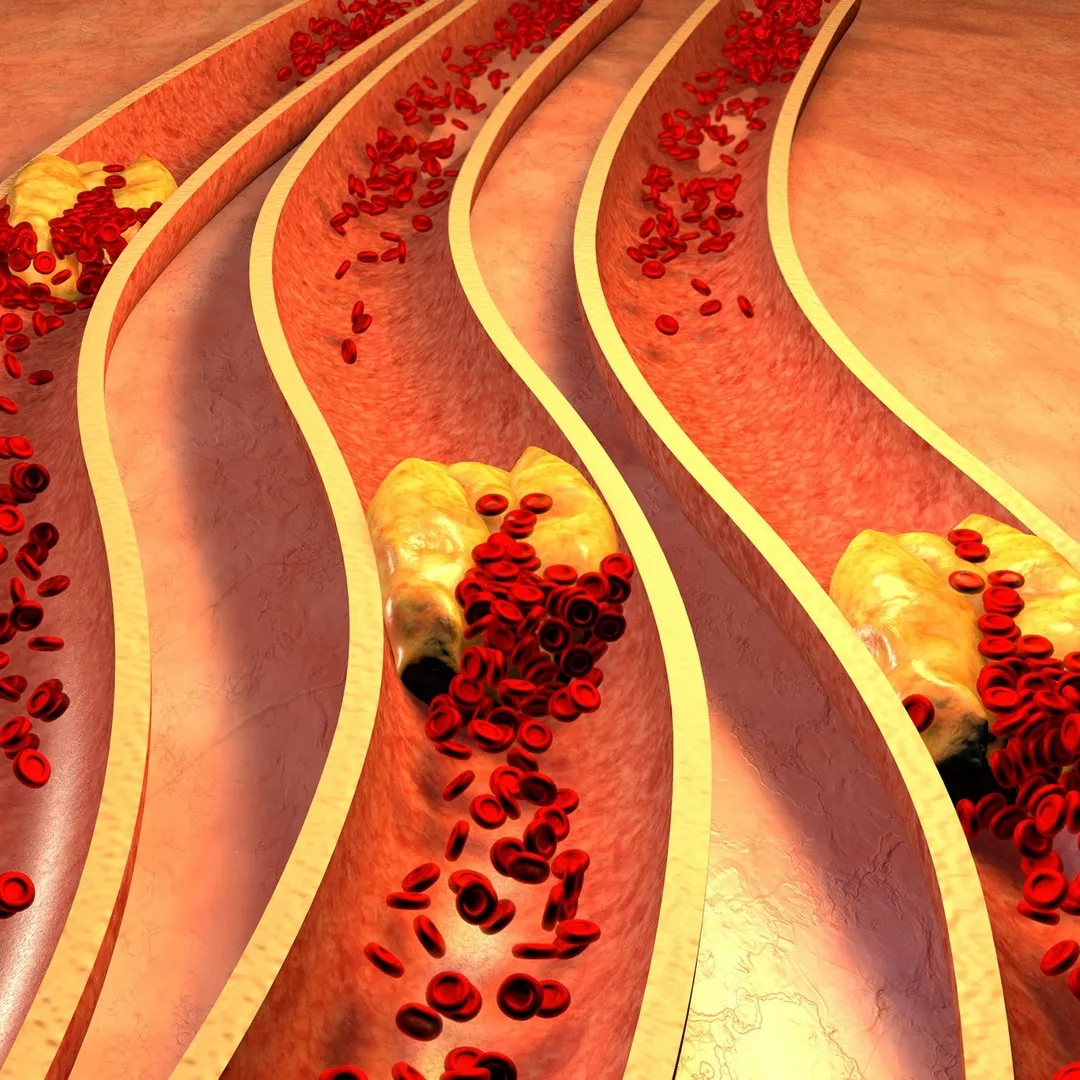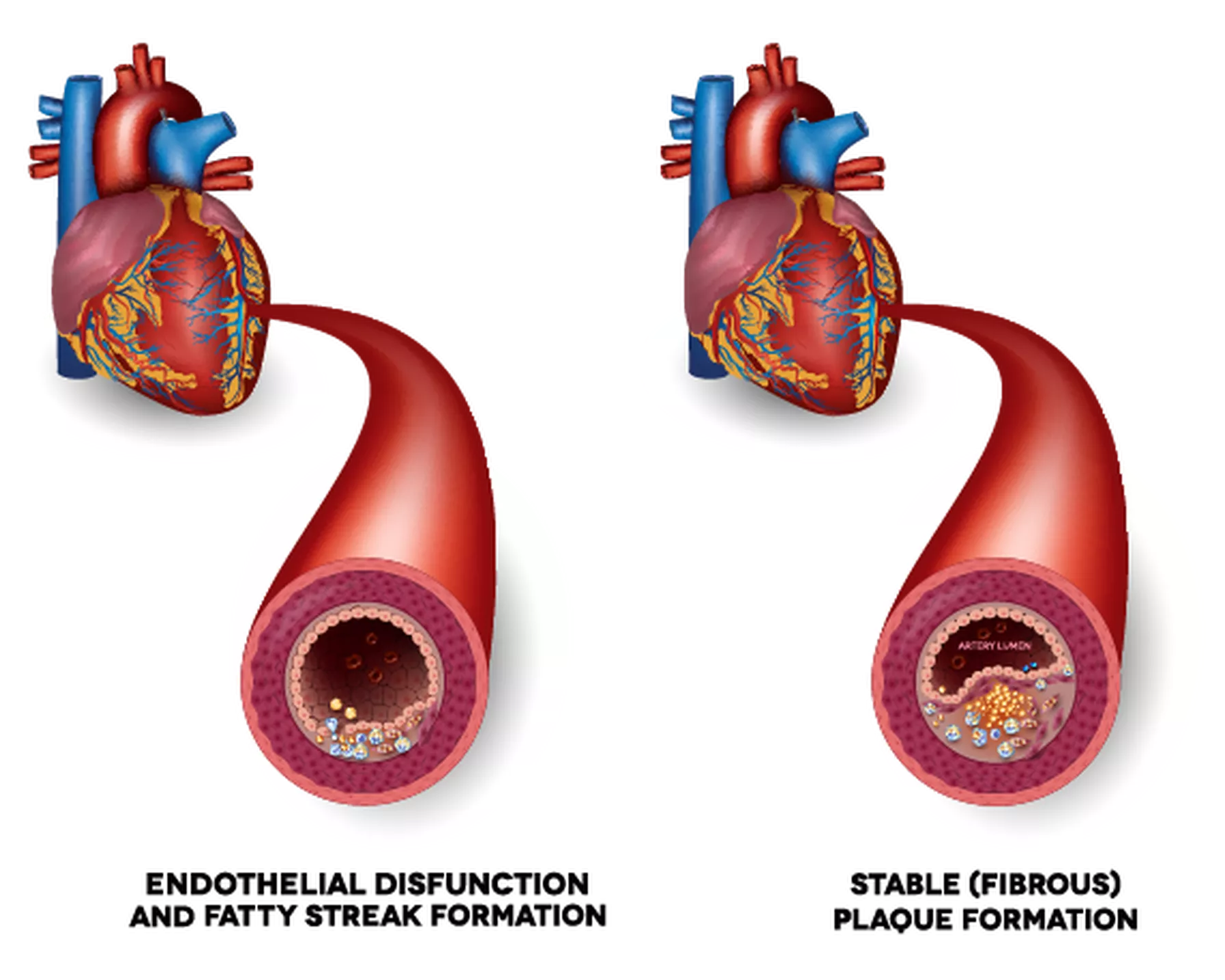What is atherosclerotic plaque in arteries?
Atherosclerotic plaque is composed of fat, cholesterol, calcium and inflammatory cells that build up on the inside of the body’s arteries.
Over time, the atherosclerotic plaque builds up, hardens and eventually narrows the opening of the arteries, reducing blood flow. The artery walls also become thickened and stiff.
Atherosclerosis – the disease in which this plaque build-up occurs – is the main underlying cause of cardiovascular disease (CVD).
Types of atherosclerotic plaque
There are two types of atherosclerotic plaque: stable and unstable.
Stable atherosclerotic plaque
Stable atherosclerotic plaque builds up over time and causes arteries to become hardened. It can lead to narrowing of the arteries over time, so much so that eventually blood flow to the heart and other organs is restricted. This obstructive stable plaque can be detected and treated.
Unstable atherosclerotic plaque
Unstable atherosclerotic plaque builds up over time like stable atherosclerotic plaque, but it is prone to rupture even before it is large enough to obstruct blood flow. Rupture of an unstable plaque can give rise to a thrombus (blood clot) that can limit, or even completely block, the flow of oxygen-rich blood to the heart, brain and other parts of the body. If the blockage occurs in one of the two main coronary arteries that supply blood to the heart, it can result in a heart attack. If the blockage occurs in one of the arteries supplying blood to the brain, it can result in a stroke.
Unstable plaques are potentially dangerous because they can cause a sudden blockage to a person’s blood flow with no warning. These plaques are difficult to detect and identify, but they can be fatal when they rupture.
Presently, there are no simple, non-invasive tests available to specifically detect unstable atherosclerotic plaque.
Development of atherosclerotic plaque (stable and unstable)
Atherosclerotic plaque causes
Atherosclerosis is a complex, slowly progressive disease that often starts in childhood and advances with age, but it can progress rapidly. The exact cause of atherosclerosis and atherosclerotic plaque build-up is not yet known, but it may start with damage or injury to the inner layer of an artery. It is also linked to certain risk factors.
The risk factors for atherosclerotic plaque
While the exact cause of atherosclerotic plaque build-up is not known, it is linked to certain risk factors.
Some of these factors that increase your risk cannot be changed, such as a family history of CVD and increasing age. Other risk factors can be managed through lifestyle changes.
- High blood pressure: This can be managed through prescribed medications. Dietary changes such as lowering salt intake can also help.
- High cholesterol: High levels of LDL (“bad”) cholesterol can be managed through medications and dietary changes.
- Obesity: Being overweight or obese can increase the risk of high blood pressure and high cholesterol.
- Diabetes: Having diabetes can double the risk of a person developing CVD. Dietary changes to manage diabetes can help decrease the risk of atherosclerotic plaque.
- Inactivity: Leading a sedentary lifestyle can contribute to being an unhealthy weight, increase the risk of high blood pressure and cholesterol levels, and the risk of atherosclerotic plaque.
- Poor nutrition: A diet high in saturated fat, trans fat, LDL cholesterol, salt and sugar can contribute to being an unhealthy weight.
- Smoking: Smoking can damage the arteries and increase the risk of atherosclerotic plaque.
- Stress: Stress can cause an increase in blood pressure by decreasing the diameter of the blood vessels. Chronic stress is also linked to CVD.
- Sleep apnoea: Sleep apnoea can lead to high blood pressure and put strain on the cardiovascular system. It occurs when a person experiences short periods (up to 90 seconds) where breathing stops while they are asleep.
Visit the risk factors page for more information.
How to prevent atherosclerotic plaque
People at risk of developing atherosclerotic plaque should be tested if possible. Atherosclerosis cannot be reversed once it starts, but early detection and the implementation of a management plan can help to prevent its progression and the build-up of atherosclerotic plaque.
You can help to prevent or delay atherosclerotic plaque from developing by reducing your risk factors through simple lifestyle changes. These include actions such as prepping a heart-healthy diet with minimal saturated fats, being physically active to help maintain a healthy weight, limiting alcohol consumption, and quitting smoking.
If you are at risk of developing atherosclerotic plaque because of risk factors such as high cholesterol and high blood pressure levels, your doctor can prescribe medications to help manage them.
Speak to your doctor if you are concerned about your risk of atherosclerotic plaque build-up.
How to eliminate atherosclerotic plaque
Atherosclerotic plaque cannot be completely removed or eliminated once it has built up in the arteries, but its size can be reduced through treatments and medical procedures. In severe cases, invasive surgery can help to remove plaque build-up and ensure that blood can continue to flow effectively through the arteries.
How is HRI fighting atherosclerotic plaque?
HRI is conducting groundbreaking research from a broad range of angles to understand how atherosclerotic plaque develops through atherosclerosis
and to find innovative ways of preventing, detecting and treating the resultant CVD.
Our Atherosclerosis and Vascular Remodelling Group focuses on identifying and gaining insights from the genetic and molecular pathways involved in the build-up of atherosclerotic plaque. These pathways could be used to improve treatments for atherosclerotic plaque.


